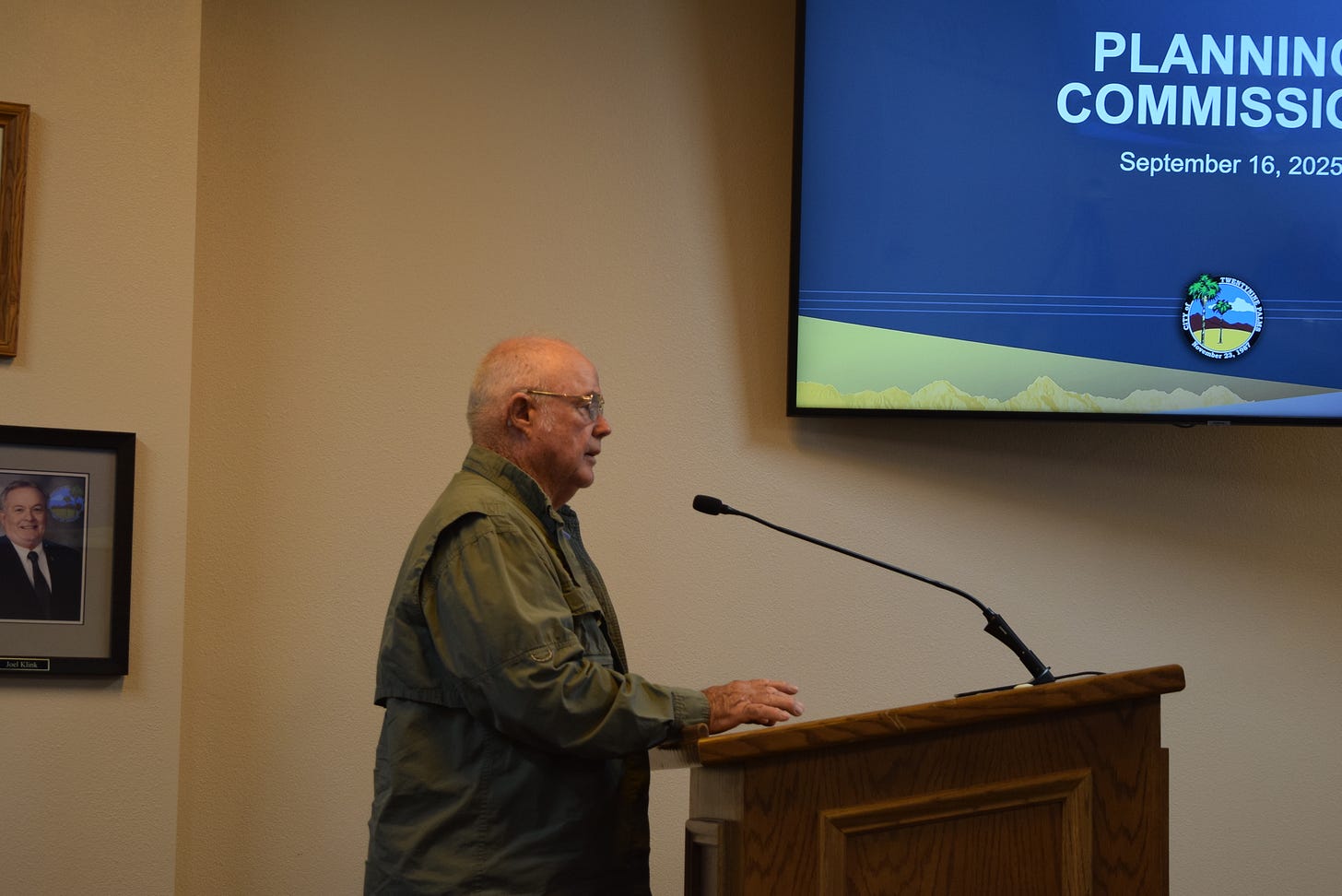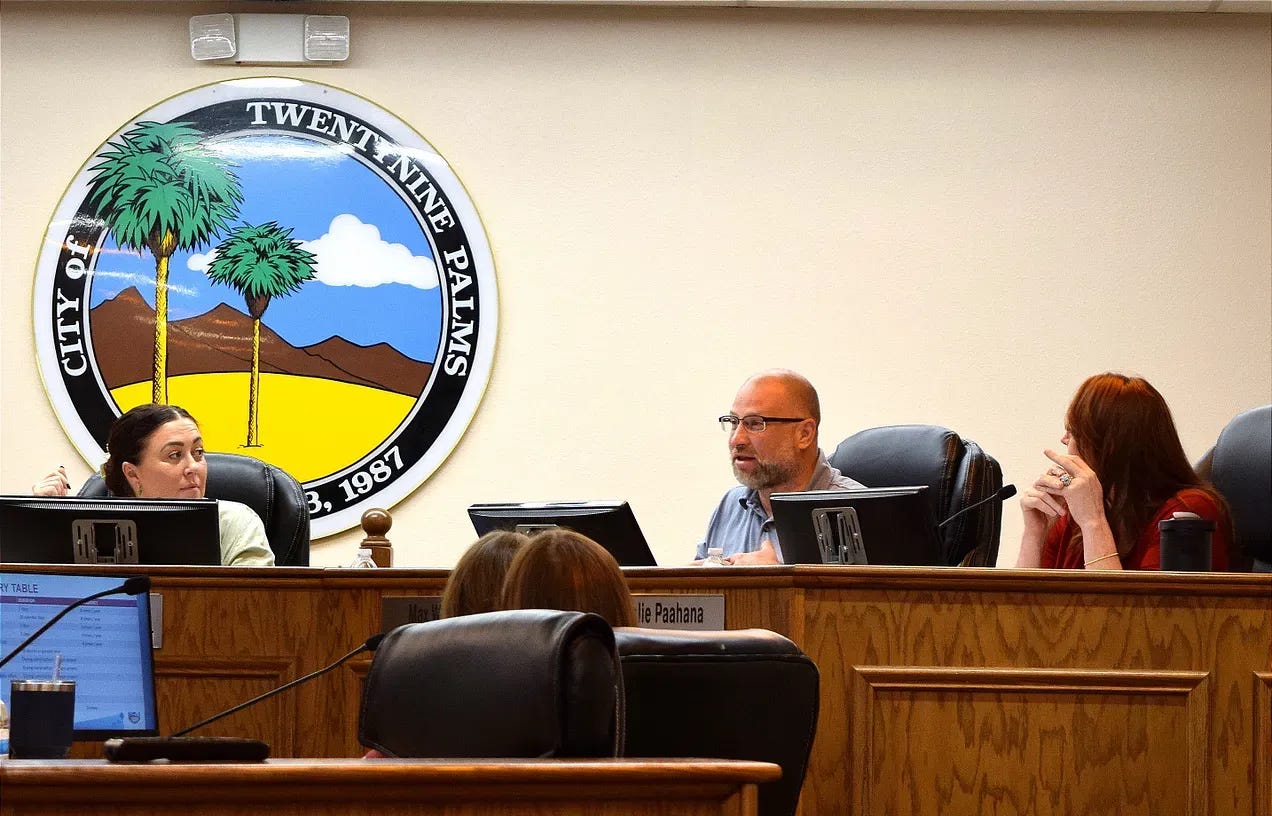RECAP: Twentynine Palms Planning Commission, September 16, 2025
Corralling the City Code—animal keeping, businesses in residential areas, and community gardens

On Tuesday, the Twentynine Palms Planning Commission held a meeting that neared the 90-minute mark. Three out of five Commissioners were in attendance, with Vice Chair Alex Garcia and Commissioner Jim Krushat having excused absences. Commissioners hosted a study session with discussion ranging from Temporary Use Permits for home business operations, sidewalk sales, pet ownership and minimum acreage requirements, to livestock keeping of cows and horses, community gardens, and greenhouse requirements.
At the meeting, staff recommendations occasionally differed from the wishes of Commissioners and the public. The Commission ultimately pushed back the three study-session topics for further staff revision and more workshops. This meeting followed a break in public meetings at the Planning Department that exceeded two months, with their last meeting having taken place June 25.
Video of the meeting is available here, and our agenda preview of the meeting is available here.
PUBLIC COMMENTS
In open public comment, resident James Knight addressed Council on recent flood damage to his property that occurred due to a berm overflowing.
Flooding damage continues— another set of thunder storms arrived in the Mojave desert this week. Roads on Amboy, Utah Trail, and Godwin were shut down Thursday, September 18, due to flooding, mud, and debris. Roads north of town in Amboy and the Mojave National Preserve have been heavily affected so expect delays if heading into and out of Las Vegas.
Highway 247, Old Woman Springs Road, sustained flood damage north of Lucerne Valley near Rabbit Springs Road. In Barstow, just 75 miles north, the body of a two year old boy swept away by Thursday’s flood waters was found Friday evening.
For the latest road closure updates, follow the City of 29 Palms Facebook page and the CalTrans website.
COMMISSION COMMENTS AND REPORTS OF MEETINGS ATTENDED
Since their last meeting, Commissioners reported attendance at local community events. Chair Cure and Commissioner Max Walker attended the July 22 City Council meeting.
CONSENT CALENDAR
The only item on the consent calendar was approval of last meeting’s minutes, which were approved 3-0.
DISCUSSION AND POTENTIAL ACTION ITEMS
None
STUDY SESSION
Discussion kicked off with Community Development Director Keith Gardner, who said City Staff is seeking guidance on three study-session topics that conflict with City code: Temporary Use Permits, Animal Keeping, and Community Gardens.
Item 2. Chapter 19.34: Temporary Use Permit regulations
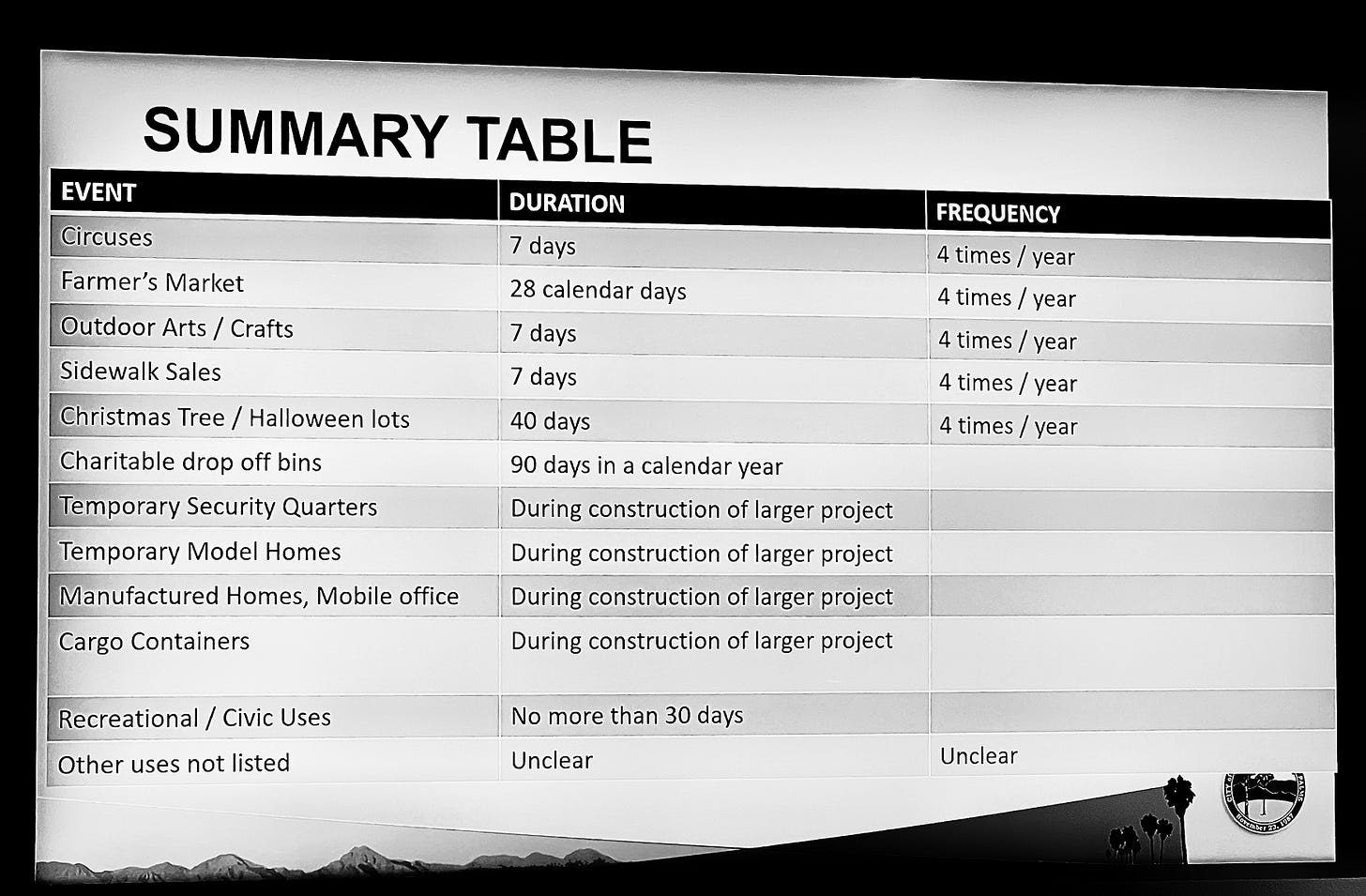
Temporary Use Permits are issued by the City and apply to a number of activities— circuses, farmers markets, outdoor crafts sales, sidewalk sales, Christmas tree lots, and “other uses not listed” such as weddings.
Regulations on Temporary Use Permits are strictly defined in the Development Code. Gardner says the Planning Department often receives requests for events that may not always meet this criteria, such as those for temporary events in residential areas.
An agenda published prior to the meeting did not contain any preliminary information on Temporary Use Permits, merely stating “That the Planning Commission study the issue, take public testimony, and provide staff direction.”
The subtopic of temporary events taking place in residential areas was not specified in the agenda packet under the listed agenda item. Commissioner and Staff discussion on the issue was nebulous as a result. Gardner stated:
Sometimes we get requests for temporary events in residential areas. It's not explicit as to whether or not these uses can be in residential areas or not, or if they're explicit to commercial areas or whatnot. So this is a little bit of guidance we're seeking.
Gardner presented a summary table with the current code, which shows what types of events are allowed for which durations. Three questions were posed for Commissioners to answer:
Are the time and event limits appropriate for the uses listed?
Should some of these use types be limited to industrial/commercial areas and prohibited in residential areas?
Should those uses be limited in frequency to four times a year?
“I'm asking for a little bit of guidance from the Commission to see if we need to be more explicit or if we've got particular leeway in unique situations,” said Gardner.
Chair Cure suggested that event types that have frequent requests, such as weddings, should be specified in the code then opened the topic to comments from the public.
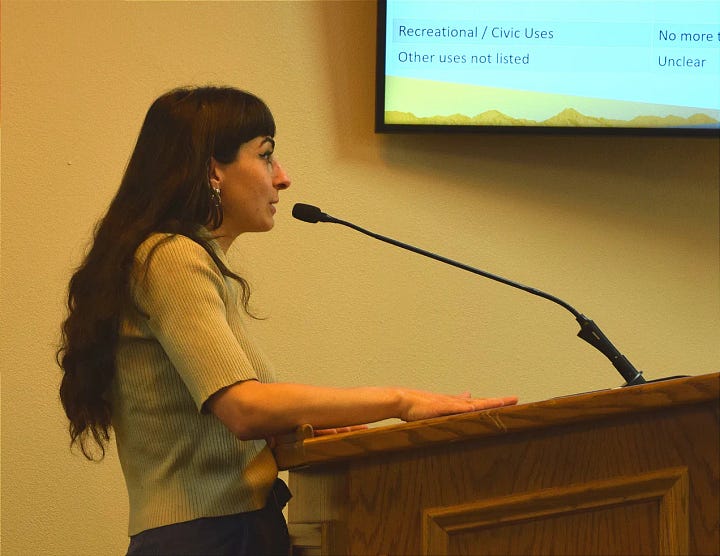
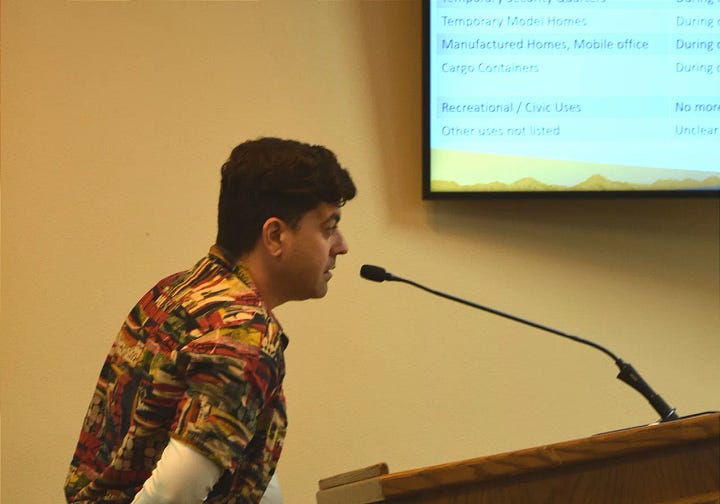
Resident Carlos Blandon heeded Commissioners on relegating absolute approval authority to a single Community Development Director (CDD), advocating for more fair-practice approval procedures:
Allowing someone just to decide all the factors when an application comes in is deadly. You need to have someone else from the planning department or someone else from the building department to decide also.1
Caroline Partamian, Executive Director of Desert Trade, spoke on behalf of the artists residency space in the Sherman Highlands neighborhood.
Partamian elaborated on Desert Trade’s events, many of which are not available elsewhere in the Morongo Basin. Founded by Emmy Award winning choreographer Ryan Heffington, Desert Trade operates in a residentially zoned area off Sherman Road under a Temporary Use Permit and holds recurring programs, including artists exhibitions, grief circles, and culturally engaging events that, in the past, have included a traditional Oaxacan ceremony with native food and interpretive dance performances.
On Desert Trade’s events, Partamian stated:
It has demand here in the high desert, and we've also received a PAAC grant to host a series of three community workshops. We've also received three TBID grants that we've successfully executed, and have gotten lots of positive reviews from the community and tourists from that, which, I know tourism is really important to the City of 29.
Partamian thanked City staff members, Commission Secretary Shelley Green, and Gardner, for working diligently with Desert Trade on this issue and concluded, “We're committed to the community, and we do believe that a more flexible permitting process would benefit. Thank you so much.”
Planning Assistant Diane Olsen highlighted massive flaws in the code as it is currently written:
I think a lot of what we're trying to get direction on is that our code is not clear, because it really does allow all of these events to take place in a residential neighborhood… Should these types of events be allowed in residential neighborhoods, or do we need to rewrite our code to limit the types of events that should be allowed in residential? Because if you look at this—circuses, carnivals— those are all listed events, but should those be allowed in a residential neighborhood?
To that, Commissioner Walker raised the point that a recent circus, which took place near Liberty Housing in a residentially zoned area, occurred on a dirt lot with ample space.
Without specifying any party or operation in particular when inquired, Gardner confirmed complaints have been made to the City regarding certain temporary activities in residential neighborhoods.
After some discussion on ancillary activities and special events permits, Cure suggested Planning staff look into the County of San Bernardino code on Temporary Use Permits for direction. Highlighting her business’s experiences of permit approval at the County level, Cure noted that County TUPs are typically valid for 12 months rather than limited to 4 events per year—a streamlined process that would be potentially easier on small businesses and municipal staff.
Olsen asked Commissioners for clarification—at what point would a temporary event have to be moved out of a residential area to a formal event center? Safety issues such as parking requirements, restroom requirements, and minimum lot size requirements were raised for each temporary use activity. Olsen, again highlighting flaws in the code, said:
I live on a quarter of an acre property. Should I be allowed to have weddings? Should I be allowed to have farmers markets? Should I be allowed to have a carnival? Because as of right now, all of those uses are allowed.
Commissioners and Planning Staff agreed that the code should be strictly defined to include limitations per location, per lot size, and per applicant. Staff leverage on unique and special situations would be allowed. The topic will likely be hashed out further in a future workshop.
Item 3. Community Gardens
Current code does not specify requirements for community gardens. The Community Development Director is also seeking Commissioner direction on greenhouse requirements. Gardner noted that the definition of a garden was quite ambiguous and did not have specific requirements as to what could be grown.
Questions posed to Commissioners included:
Is the administrative determination of the Community Development Director that any garden can be grown in any place acceptable?
Should greenhouses be an allowed use for community gardens?
If greenhouses are allowed, should they require a Conditional Use Permit, Administrative Use Permit, or a Site Plan Review?
Should greenhouses be subject to architectural design guidelines?
If a greenhouse is built and a garden goes away, should the greenhouse be removed?
After public comment from Carlos Blandon, Commissioners tackled each question line by line. With regard to community gardens, Commissioner Paahana said she was apprehensive about a large greenhouse, raising the issue of community safety and security with something unlocked and open to the public. Pahaana suggested that building and structural inspections be included in the permitting process if they are allowed. Garden projects of larger scope and size should require Conditional Use Permits.
Commissioner Walker was in favor of greenhouses but adamant that if a garden is removed then stipulations should require any greenhouse structure affiliated with the garden should also be removed, to reduce blight and reduce the City’s financial burden of removing dilapidated structures.
Chair Cure emphasized the concept of a community gardens versus a private or commercial garden.
I think it needs to be a certain size, because it's not really a community garden if it's just a small thing. But ultimately, community garden means that anybody can go to it, right?
Discussion turned to accessory structures and small gardens shared among neighbors in residential areas versus larger gardens in commercial areas. Commissioners requested that staff clarify zoning and size requirements to determine which level of permitting would be appropriate for potential community gardens. CUPs require more administrative review than AUPs.
Gardner will bring this back for future discussion:
We'll see if we can define this a little bit further, but what I'm hearing is that there's potential to allow this to happen.
Item 4. Chapter 19.1021: Animal Keeping
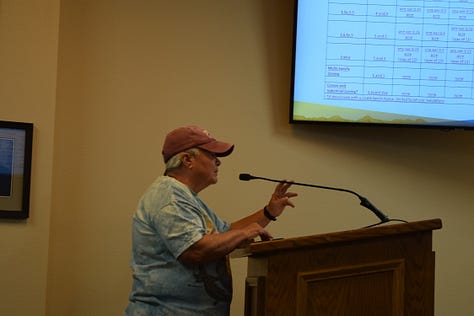

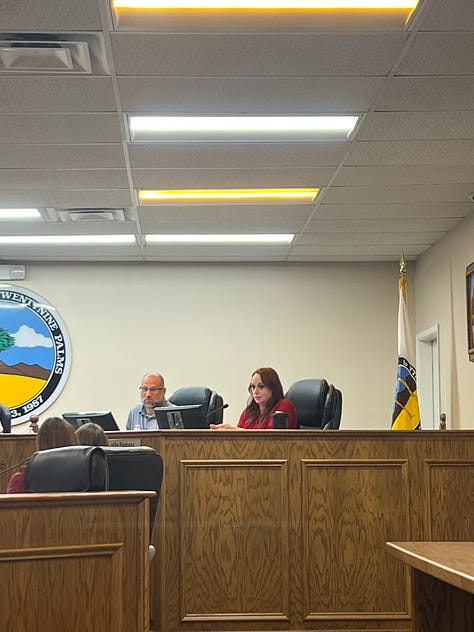
Animal Control Officer Rick Boyd was at the meeting to field questions on this topic. This is a revamp of the City’s current Animal Control code. Because Animal Control falls under Planning, the two departments are working together.
Some changes include maximum pet allowance requirements. Currently, the number of pets one can own is determined by zoning type. Gardner says, “So, it's conceivable that someone may have a single family residence and have two acres, and living happily on it, but they're limited on how many animals they can have.”
Gardner presented a chart with suggestions, which Desert Trumpet highlighted in our agenda preview. On 5-acre residential lots, for example, Planning proposes that one could own five dogs and five cats rather than the current limit of two each.
Gardner raised the issue of dog grooming businesses in residential areas as part of home occupancy uses, asking Commissioners if they should be allowed, and if so, how to enforce regulations.
Speaking from the public was Kim Ortamond, who, along with many neighbors, owns horses. Ortamond said she previously served on a general plan advisory committee that helped determine the current minimum acreage of 4 horses per one acre. With animal welfare in mind, Ortamond is worried residents will keep horses in lots that are too small.
Rick knows me. I've had a lot of horses, and when we came up with that, I will tell you, I would probably rephrase it a little. I wouldn't have four horses if I only had one acre. That's just too small of an area. I almost have eight acres, and presently I’m at six horses. It goes up and down, as Rick knows, but the biggest thing I would say, one acre is not capable of having four horses with a house on it. Maybe two horses, if that.
Chair Cure asked questions on behalf of Commissioner Garcia, who inquired on the issue of dog grooming in residential areas. Garcia noted the benefit home occupancy allowances serve in low-income communities, allowing those with disabilities, single parents, and veterans to make a living.
Mobile dog grooming is allowed under current code, where the groomer goes to a pet owner’s residence to conduct business, but dog grooming out of a home office space is not. The Community Development Director is seeking clarification from Planning Commissioners on the issue.
Officer Boyd was asked his thoughts on dog grooming operations in residential areas. Boyd raised concerns of parking and traffic going in and out of neighborhoods and sanitation. “Barking dogs anytime could be a public nuisance,” said Boyd.
If someone grooms four dogs a day, or twenty dogs per week, Boyd asks “Where would hair, feces, things like that go? Urine, you know, things like that. Where would that stuff go on a day-to-day basis?”
Commissioner Walker noted inconsistencies in the suggested chart, highlighting that reptiles were not included. Paahana favored the chart but also agreed specifics were necessary. Further definition of pet ownership in commercially zoned areas was requested.
Ultimately, Commissioners agreed that animal keeping issues should be relegated to Animal Control since they’re the experts on animals, which will be executed with a well-written policy from the Planning Department. Animal Entitlement Permits will be issued by Animal Control, with the option for a well-defined appeal process to the Planning Department if a permit is denied.
Gardner said he would bring the issue back in another study session. Commissioner Cure requested another study session on animal keeping, and then a separate study session on home occupations as a whole.
COMMUNITY DEVELOPMENT DIRECTOR UPDATES
Gardner announced that the housing and homeless subcommittee that previously consisted of Planning Commission and members of the public has now reformed as a City Council subcommittee. Councilmembers April Ramirez and Octavious Scott are the two current members.
Speaking on the General Plan, Gardner says the City is in preliminary stages to be looking at land use types and appropriate zoning types throughout the City. Gardner is hoping to assist the City with further incorporation of its new open-space conservation zoning type that was established in July.
The next Planning Commission meeting will take place October 7, 2025 at 5 pm.
Leave your thoughts in the comments below. Please note that we do not allow anonymous comments. Please be sure your first and last name is on your profile prior to commenting. Anonymous comments will be deleted.
Feel free to share this article!
Help us reach our 2025 goal of $10,000 in subscriptions! Upgrade to a paid subscription for just $5 per month or $50 per year.
Would you care to donate more than $100? Our Paypal account is up and running!
While the CDD is authorized to approve some administrative permits without Commissioner approval or a public hearing, Commissioners retain ultimate authority over the CDD through an appeals process.


